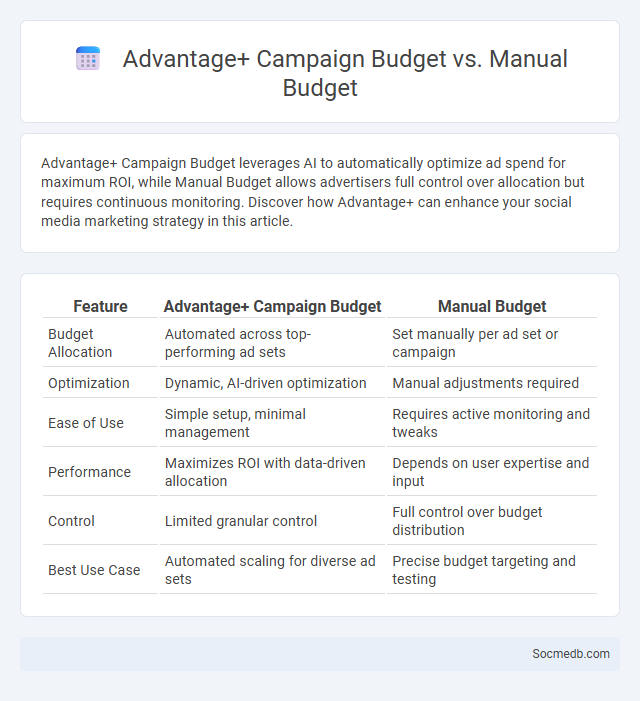
Photo illustration: Advantage+ Campaign Budget vs Manual Budget
Advantage+ Campaign Budget leverages AI to automatically optimize ad spend for maximum ROI, while Manual Budget allows advertisers full control over allocation but requires continuous monitoring. Discover how Advantage+ can enhance your social media marketing strategy in this article.
Table of Comparison
| Feature | Advantage+ Campaign Budget | Manual Budget |
|---|---|---|
| Budget Allocation | Automated across top-performing ad sets | Set manually per ad set or campaign |
| Optimization | Dynamic, AI-driven optimization | Manual adjustments required |
| Ease of Use | Simple setup, minimal management | Requires active monitoring and tweaks |
| Performance | Maximizes ROI with data-driven allocation | Depends on user expertise and input |
| Control | Limited granular control | Full control over budget distribution |
| Best Use Case | Automated scaling for diverse ad sets | Precise budget targeting and testing |
Introduction: Understanding Facebook Ad Budget Options
Facebook ad budget options offer businesses flexible ways to control spending and maximize return on investment through daily or lifetime budgets. Choosing the right budget type influences ad delivery, audience reach, and campaign efficiency, with daily budgets setting a specific spend per day and lifetime budgets allocating a total amount over the campaign duration. Understanding these options enables marketers to tailor advertising strategies that align with campaign goals and financial constraints.
What is Advantage+ Campaign Budget (ACB)?
Advantage+ Campaign Budget (ACB) is an automated budget allocation tool designed to optimize your social media advertising campaigns by distributing funds across high-performing ad sets. ACB uses machine learning algorithms to analyze real-time data, maximizing reach and engagement while minimizing cost per result. You benefit from increased efficiency and improved campaign outcomes without the need for manual budget adjustments.
Manual Budget: Core Features and Functionality
Manual Budget in social media management enables precise control over advertising spend by allowing users to allocate specific amounts for campaigns, ensuring optimal resource distribution. This feature provides detailed tracking and adjustment capabilities, facilitating performance-based budget modifications to maximize ROI. Integration with platform analytics ensures real-time monitoring, helping marketers maintain budget discipline while targeting key demographics effectively.
Defining the Ad Auction Process
The ad auction process in social media platforms determines how advertisements are displayed to users by evaluating bids from multiple advertisers competing for the same audience. This process factors in bid amounts, ad relevance scores, and user engagement metrics to optimize both advertiser goals and user experience. Key platforms like Facebook and Instagram use machine learning algorithms to dynamically rank ads, ensuring the most effective content reaches targeted demographics.
Key Differences: Advantage+ Campaign Budget vs Manual Budget
Advantage+ Campaign Budget leverages AI-driven automation to dynamically allocate funds across ad sets, optimizing performance based on real-time data and audience behavior. Manual Budget requires advertisers to set fixed daily or lifetime budgets for each ad set, offering more control but less flexibility in adjusting spend automatically. Campaigns using Advantage+ often result in better cost-efficiency and higher engagement due to adaptive budgeting tailored by Facebook's algorithms.
Performance Optimization: How Each Budgeting Method Impacts Results
Performance optimization in social media depends heavily on the chosen budgeting method, as cost-per-click (CPC) budgets often maximize engagement by targeting specific audiences, while cost-per-impression (CPM) budgets enhance brand awareness through broader reach. Daily budgeting allows consistent ad delivery and pacing, helping Your campaigns maintain steady performance, whereas lifetime budgeting provides flexibility to allocate funds according to overall campaign goals and optimize for conversions. Understanding how each method influences impressions, clicks, and conversions is crucial to fine-tuning Your social media strategy for measurable results.
Cost Efficiency: Comparing Budget Allocation Strategies
Optimizing your social media budget involves evaluating cost efficiency by comparing various budget allocation strategies such as pay-per-click advertising, influencer partnerships, and organic content creation. Data-driven analysis reveals that diversifying spend across these channels often yields higher ROI by balancing immediate engagement with long-term brand growth. You can maximize cost efficiency by reallocating funds based on real-time performance metrics and audience targeting precision.
Audience Targeting and Delivery Implications
Audience targeting in social media leverages demographic data, behavioral insights, and psychographic profiles to deliver highly personalized content, maximizing engagement and conversion rates. Precise targeting ensures ads reach users most likely to be interested, reducing ad spend wastage and improving ROI for marketers. Delivery algorithms optimize content distribution timing and platform placement, affecting visibility and user interaction across diverse social media ecosystems.
Use Cases: When to Choose ACB, Manual Budget, or Focus on Ad Auction
Choosing between ACB, Manual Budget, or Ad Auction depends on your campaign goals and budget control preferences. Use ACB (Automated Campaign Budget) when seeking optimization across ad sets for maximum ROI without constant management. Opt for Manual Budget to maintain strict control over spending per ad set, ideal for precise targeting, while Ad Auction is best when leveraging platform algorithms to dynamically bid for impressions in real-time, maximizing reach and efficiency.
Conclusion: Selecting the Optimal Budget Strategy for Your Campaign
Selecting the optimal budget strategy for your social media campaign hinges on aligning your financial resources with clearly defined marketing objectives, audience targeting, and platform analytics. Data-driven approaches such as performance-based budgeting enable maximized return on investment by allocating funds dynamically to high-performing ads and content. Continuous monitoring and adjustment ensure sustained engagement, growth, and efficiency in reaching desired campaign outcomes.
 socmedb.com
socmedb.com